Neglecting your greenhouse this winter? Here are 11 ways it can keep your yard productive during the colder months
From sowing seeds, to storing tender plants, and growing herbs, a greenhouse can actually be a busy place in winter
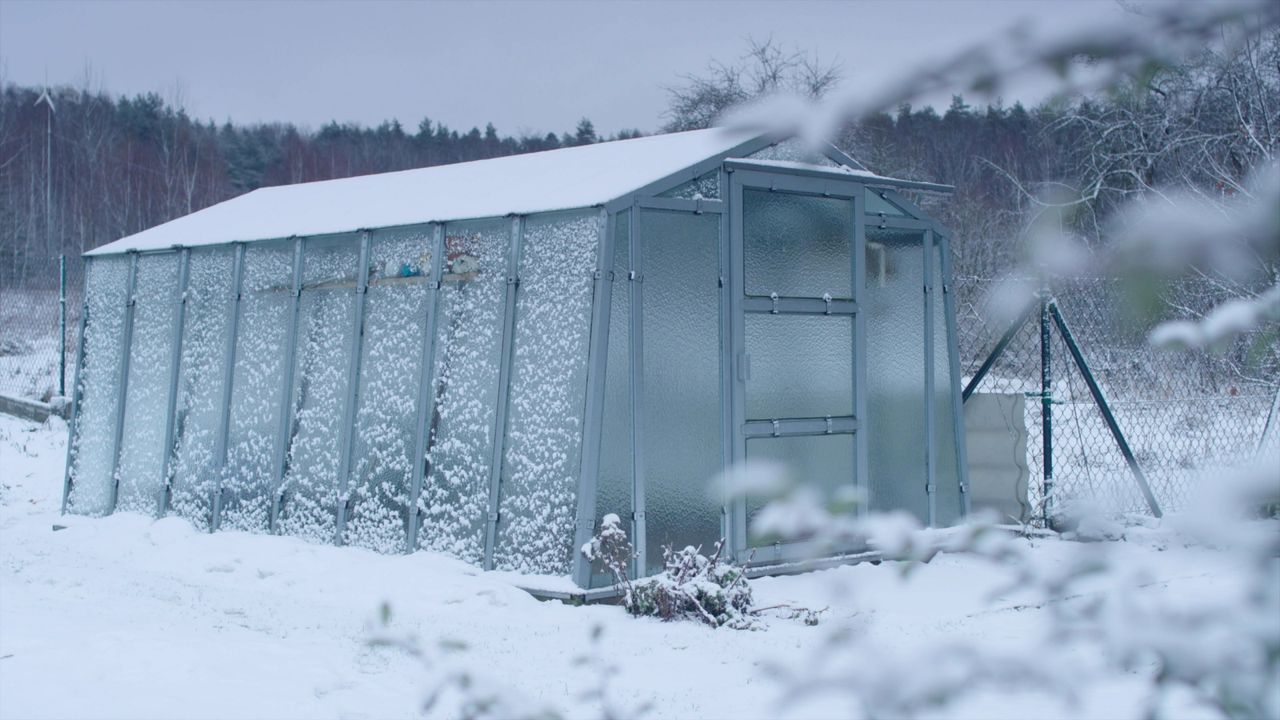

Tenielle Jordison
It may surprise you to learn that in the midst of winter, a greenhouse is one of the most useful pieces of equipment gardeners can own.
Greenhouses get a lot of use in spring and summer, whether it's for sowing seeds, taking plant cuttings, or growing tomatoes, eggplants, and other vegetables. It's also common to winterize the greenhouse, making sure it's structurally safe, before leaving it neglected and empty in the colder months.
However, you could actually use it much more productively during this time. Whether heated or cold, your winter greenhouse is a haven for overwintering plants, starting hardy annuals, growing salads, nurturing cuttings, getting an early start with summer beauties, and so much more. Here are some of the best ways to use a greenhouse in winter.
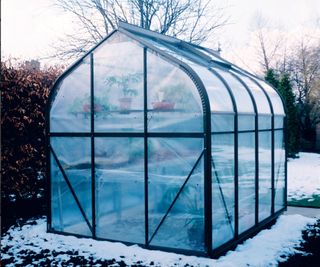
A greenhouse offers gardeners (and their plants!) so many opportunities in winter
11 ways to use a greenhouse in winter
Heating your greenhouse will give you much greater flexibility when it comes to growing plants undercover through winter. But even if your greenhouse is unheated, it will still play an important role in your yard during the colder months – though you will need to take extra care with insulation.
My greenhouse is unheated and plants survive very happily in temperatures that fall well below zero. I make sure I have rolls of frost-protective fleece and bubble wrap close to hand to wrap around pots and throw over plants during the coldest snaps.
Based on my gardening experience, here are my top 11 ways to use a greenhouse in winter that you could easily do, too:
1. Store tender plants
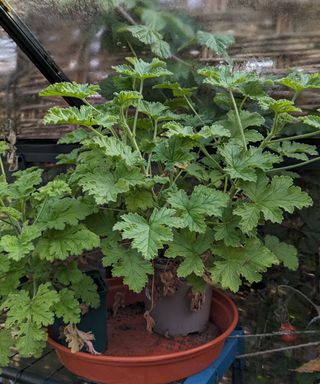
Keep tender plants such as pelargoniums frost-free in your greenhouse in winter
On your winter gardening checklist, it's likely you'll have overwintering tender plants, including overwintering pelargoniums, penstemons, gazanias, fuchsias, and gaillardias.
However, they will happily sit out winter in a greenhouse as long as they have some form of extra protection on very cold days and nights.
Lift them from the soil before the first frosts and pot them up in potting soil. Water them, then set them on your greenhouse shelves making sure their leaves don’t touch.
Good airflow around plants is essential for their wellbeing through winter and helps prevent fungal problems, such as botrytis gray mold. Leaving space between your plants also makes it harder for pests to move between them.
In winter, plants enter a dormant state and do not need feeding or watering until spring, though they may need a drink if they start to wilt in late winter.
2. Overwinter corms and tubers
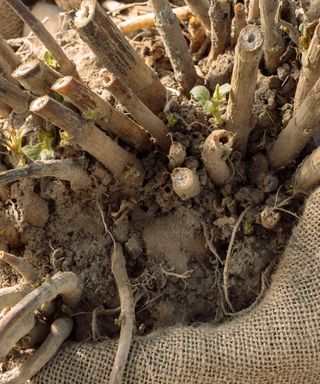
Winterize dahlia tubers in trays or sacks of dry, sandy soil
The bulbs, corms, and tubers of dahlias, canna lilies, gladioli, and freesias don’t reliably survive a winter in cold, wet soil.
They can be dried and stored in trays of dry, sandy soil in a cool, dry greenhouse. Alternatively, wrap them with some dry soil in burlap sacking, like this robust roll by Burloptuous, available on Amazon.
Wait until the first frost has blackened the leaves of dahlias and cannas before lifting them.
If they are already growing in containers rather than the soil, simply cut the stems down to four inches above the compost and move the whole pot into your greenhouse. You'll need essential pruning tools to do this - like these pruning shears from Amazon.
Always leave a length of stem intact, because this is where the new shoots will appear from next spring. You can lift the tubers and restart them in pots of fresh compost when spring comes around, and they will soon throw out new shoots.
It isn't just tubers and corms that can be stored in a greenhouse, either: 'Pepper plants and eggplants can be pruned back and stored,' says Sarah Akovic, vegetable growing expert. 'This helps the plant lie dormant in the cooler months while offering protection and a higher temperature. You can harden-off and transplant these plants back outside after your last frost date to get a head start on your pepper and eggplant production,' she adds.

Sarah currently teaches Crop Production at Lorain County Community College for the Sustainable Agriculture Program. She previously managed the Greenhouse at Case Western Reserve University Farm, has worked as a Regenerative Farmer on various farms, and completed grant work to enhance food justice in Lorain, Ohio.
3. Nurture cuttings
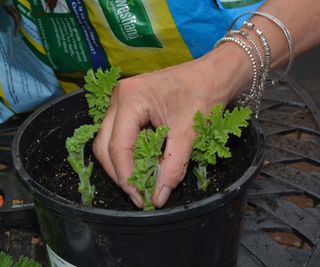
Inserting pelargonium cuttings into a pot of gritty potting soil
I always like to take a few penstemon and pelargonium cuttings in the fall to act as an insurance policy in case the parent plants succumb to the cold.
They quickly root and will be happy in your greenhouse over winter as long as they are watered sparingly and protected with fleece during the coldest spells.
In spring, pot up the cuttings in fresh potting soil and they will soon start to grow. They can be planted in the yard in early summer, when the frosts have passed and they have been hardened off.
Similarly, you can go ahead and propagate plants to multiply in December using a greenhouse: 'You want to take cuttings from woody herbs like rosemary or lavender, for example, and let them root in trays. The humidity and light of a greenhouse can mimic spring, fooling plants into new growth,' explains Valeria Nyman, gardening expert and Chief Product Officer at Taim.io.

Valeria is the Chief Product Officer at Taim.io, an innovative platform that serves as a personal, adaptive gardening coach, offering tailored weekly advice to users. As a Product Designer and strategic leader, Valeria bridges the gap between business vision and user-centered design, crafting intuitive experiences that drive both engagement and satisfaction.
4. Sow hardy seeds
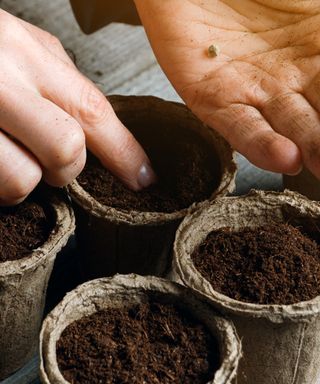
Sow seeds of sweet peas and other hardy annuals in the greenhouse in winter
Hardy annuals, such as sweet peas, cornflowers, rudbeckia, and pot marigolds can be sown in the fall and late winter, as well as other plants to sow in December, ready to bring early summer color to your yard.
Sow the seeds thinly in pots or trays of seed compost - these seed trays from Amazon work well. Cover them with a light layer of compost or vermiculite, water and add a lid to the tray, or seal the pot in a clear plastic bag.
Keep the compost damp but not soggy, and they will soon germinate. Remove the lid or bag when seedlings appear and let them grow until they are ready to pot on individually into small pots or modules.
Keep them free of pests and diseases and they can be planted out once they have been hardened off.
5. Grow winter salads and herbs
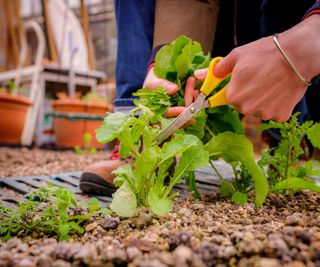
Grow cut-and-come-again salads in your winter greenhouse
One of the things I miss in winter is the ready availability of fresh salads and herbs in the garden. Luckily, they can be cultivated all year round in the greenhouse.
I use the summer’s growbags that previously contained tomatoes. Simply remove all the old plant material and any pests and enrich the compost with a general fertilizer such as Burpee Natural Purpose Organic Food, available on Amazon. Sow the seeds thinly for the best results.
You can sow hardy varieties of cut-and-come-again leaves now, and they will produce leaves that can be snipped off for salads - and then quickly grow back.
'Snipping fresh cilantro or parsley in December extends the gardening season big time,' says Valeria. 'Also, herbs like chives, parsley, and mint bounce back fast in the milder greenhouse climate,' she adds.
Spring onions, spring cabbages, kale, and arugula can also be sown and grown in a frost-free space.
6. Sow fava beans
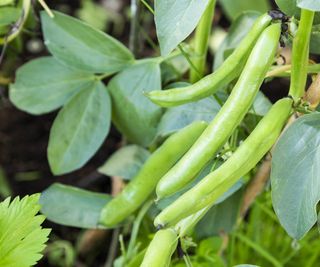
Start your fava bean crop in the greenhouse in winter
Many varieties of beans are frost-tender, but fava beans (also known as broad beans) are more hardy and can be started in your greenhouse.
Sow one bean in a small pot and then plant them out in fertile, free-draining soil in spring once they have been acclimatized to outside conditions.
They will grow quickly and crop earlier than fava beans sown straight into the soil outside in spring, giving you a longer crop.
You can find fava beans to sow at Walmart
7. Propagate strawberries

Another crop to make a start on in your winter greenhouse is strawberries. More specifically, you can grow strawberries from a strawberry during this season.
'Strawberry plants can be propagated in the fall and stored in pots over the winter.' says Sarah Akovic. 'This allows them time to work on their root systems to establish a happy and healthy plant in the spring,' she adds.
To propagate strawberries from a strawberry, collect the seeds from the fruit. The seeds will need to go through a period of seed stratification before then sowing the seeds in a seed starter tray with a seed starting mix - like Back to the Roots Natural and Organic 3-in-1 Seed Starting Mix available at Walmart.
Keep your propagated strawberries in a bright spot in your greenhouse to encourage sprouting before planting them out in your yard when the weather warms up and the risk of late frost has passed.
8. Store citrus plants
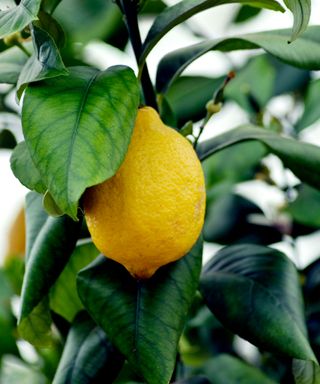
Move citrus trees undercover in cold winters
Although citrus trees grow all year round and often produce fruits and flowers in winter and early spring, they don’t like the cold and wet. If you have one growing in a pot, and it’s easy to move, relocate it in the greenhouse if you suffer from freezing winters.
If your greenhouse is unheated, I would mulch the top of its container with straw and wrap frost-protecting fleece, like this plant cover available on Amazon, around the pot to stop the potting soil from freezing.
You should fertilize citrus trees throughout the year and a general fertilizer will help through winter (like this citrus fertilizer from Amazon). Water every few weeks with rain water, letting the potting soil dry out in between.
9. Create a succulent planter
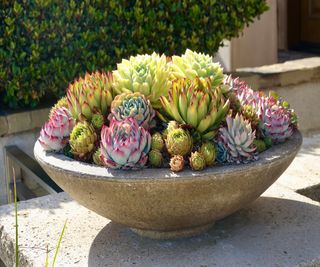
Plant an attractive succulent container in your greenhouse, ready for summer in your yard
Succulents and cacti are fascinating and relatively easy to grow, plus you can create a visual statement in your yard by making a succulent planter. Late winter is the perfect time to do this under cover in the greenhouse, ready for placing outside when the weather warms up.
All you need is a suitable pot with plenty of drainage holes, and a bag of cactus or succulent potting mix which contains lots of grit for easy drainage (like this Miracle Gro succulent potting mix on Amazon) because cacti and succulents are prone to rotting in damp conditions.
The other thing to remember is to buy a selection of plants that all have the same requirements when it comes to light and care, and check how large they grow so the more robust ones don’t overpower their smaller neighbors.
The best types of succulents to grow include aloes, sempervivums, lithops or ‘living stones’, and sedums. Don’t overcrowd the pot and they will soon grow to become an exquisite and interesting addition to your greenhouse and yard.
10. Restart tender tubers
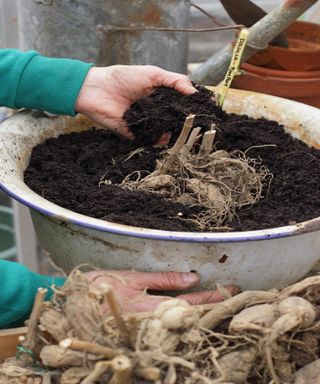
Pot up dahlia tubers, and other tender corms and bulbs, in your greenhouse in spring
Once winter has passed, and your greenhouse is getting warmer in early spring, it’s time to restart dahlia and canna lily tubers under cover of the greenhouse.
Make sure they have stayed sound through the winter and discard any that feel soft or have started to rot.
Pot them up in containers of potting soil for seeds, like this Espoma organic compost available from Amazon, as this will help them develop strong young roots.
Keep the potting soil damp but not soggy and once the tubers start to make new shoots, remove two or three to use as softwood cuttings for more dahlias for free.
11. Plant lily bulbs in early spring
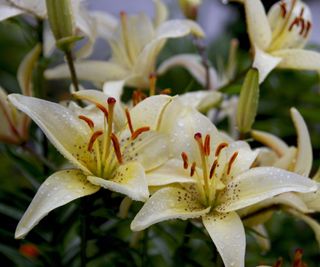
For elegance and exotic colours, plant lily bulbs in containers undercover in early spring
If you love growing lilies, you can start planting lily bulbs in containers in your greenhouse in late winter to early spring, ready for an elegant and exotic summer show.
Because they have been started under cover and earlier than their counterparts in the yard, they will flower earlier, giving you extended color. Plant your lily bulbs in a large pot, around two inches apart at around three times the depth of the bulbs.
They appreciate good drainage, so mix your potting soil with grit and, because they are also hungry plants, add some general fertilizer - like this one from Amazon.
They can be moved to a sheltered area in the yard when the frosts have passed. Make sure you raise the container off the ground to give the bulbs the best possible drainage.
FAQs
What is the easiest way to insulate a greenhouse?
The easiest and most affordable way to insulate a greenhouse in winter is to pin bubble wrap to the interior framework. Big rolls of it are widely available online - like this bubble wrap from Walmart - as are the clips that secure it to the greenhouse frame. It is easy to install and remove in spring.
Another option for greenhouses not affected by the hardest winters is to use insulating fleece to wrap around and over plants. Make sure you remove it when the temperature rises as it can trap moisture which may cause rotting and mold to develop.
Whichever method you use, it's also important to ventilate a greenhouse to provide good airflow for your plants and reduce the risk of fungal issues.
Although it is winter, plants in a greenhouse still need light and air. For this reason, make sure you clean your greenhouse windows inside and out before moving plants in, and don't forget to open doors and windows in the day for ventilation. It's important to then close up your greenhouse at dusk to keep in the warmth and keep out pests looking for shelter.
Sign up to the Homes & Gardens newsletter
Design expertise in your inbox – from inspiring decorating ideas and beautiful celebrity homes to practical gardening advice and shopping round-ups.

Ruth is a Contributing Editor for Homes & Gardens, and formerly Gardening Editor of Amateur Gardening magazine. She is horticulturally trained, with a qualification from the Royal Horticultural Society. Her work for Amateur Gardening, the world's oldest weekly gardening publication, involved matching gardening tasks with each season, covering everything from sowing and planting, to pruning, taking cuttings, dealing with pests and diseases and keeping houseplants healthy. She is an expert in ornamental plants and edible crops, and everything she writes about and photographs is in her own garden, that has been a work in progress since her family moved there in 2012.
- Tenielle JordisonNews Writer (Gardens)
-
 How to layer window treatments like an interior designer with these expert-approved tips for creating perfect pairings
How to layer window treatments like an interior designer with these expert-approved tips for creating perfect pairingsExperts share their foolproof tips for mixing curtains, blinds, and shutters for a polished, designer look
By Charlotte Olby Published
-
 Art Nouveau vs Art Deco – what's the difference between these two classic design styles?
Art Nouveau vs Art Deco – what's the difference between these two classic design styles?With Art Deco turning 100, it's time to understand the key differences between two of the most iconic styles of the 20th century
By Eleanor Richardson Published